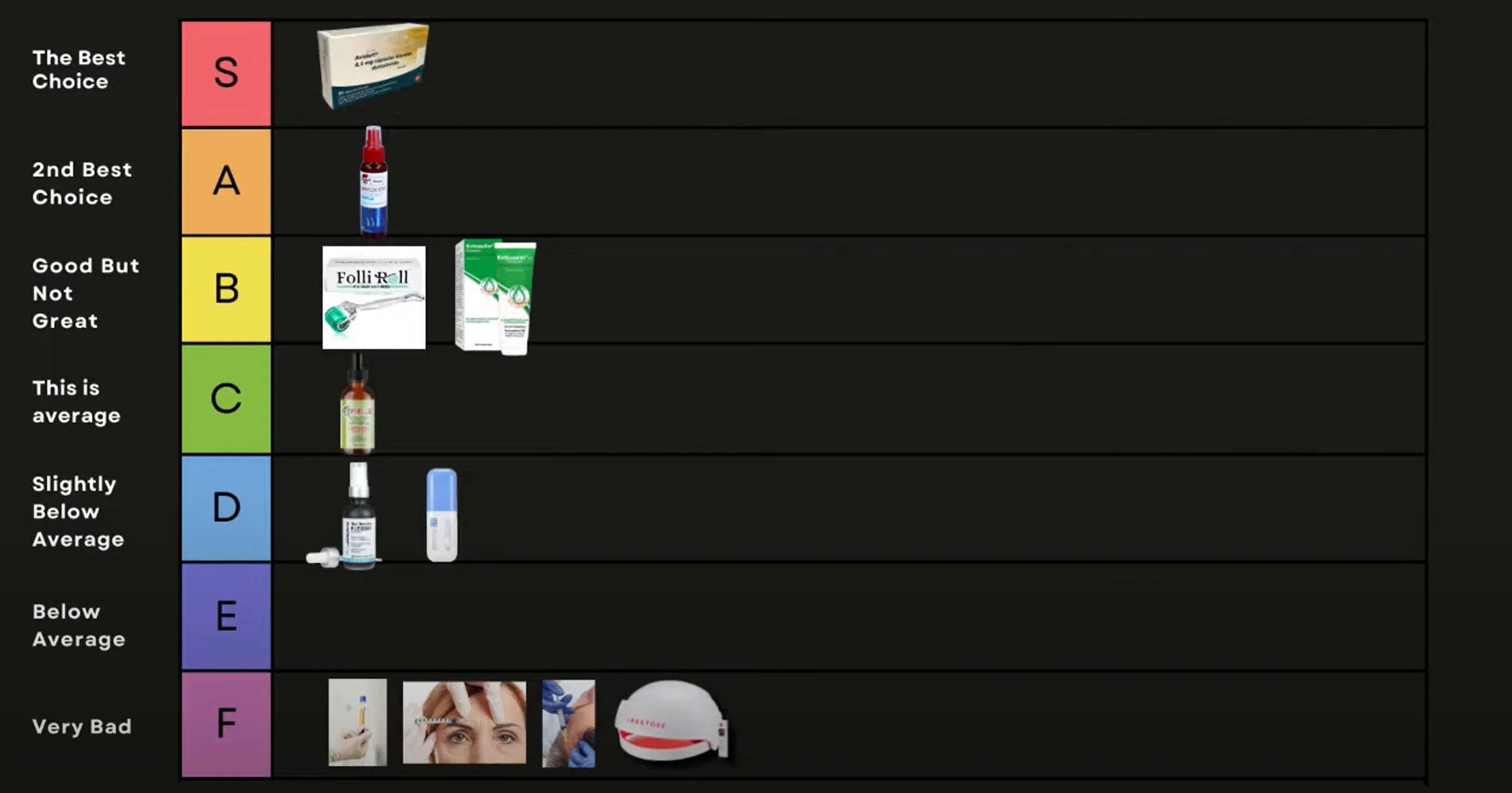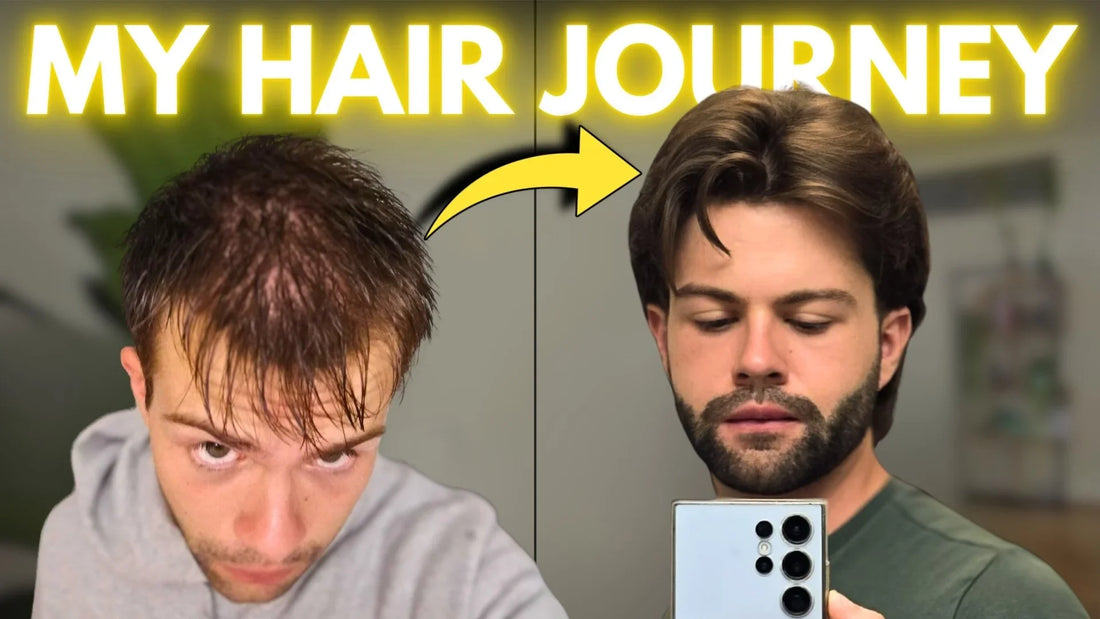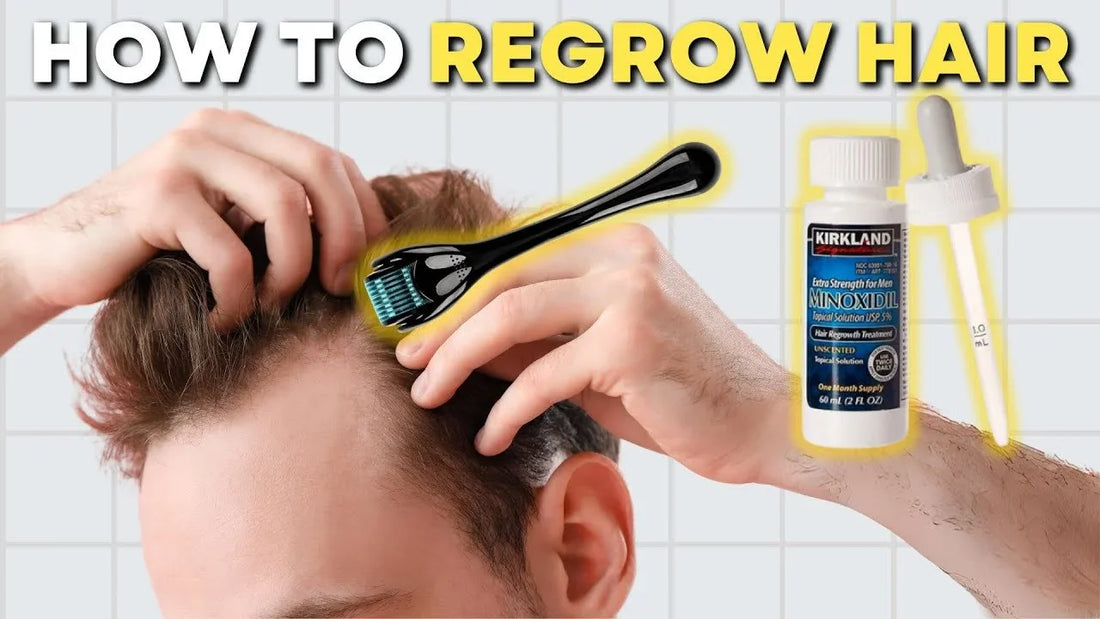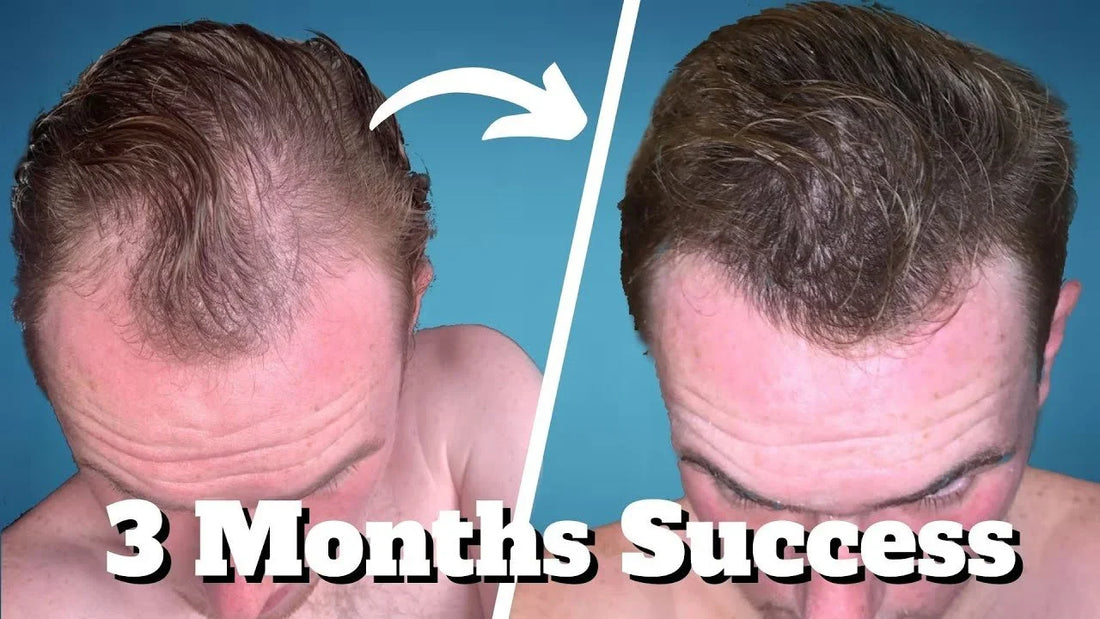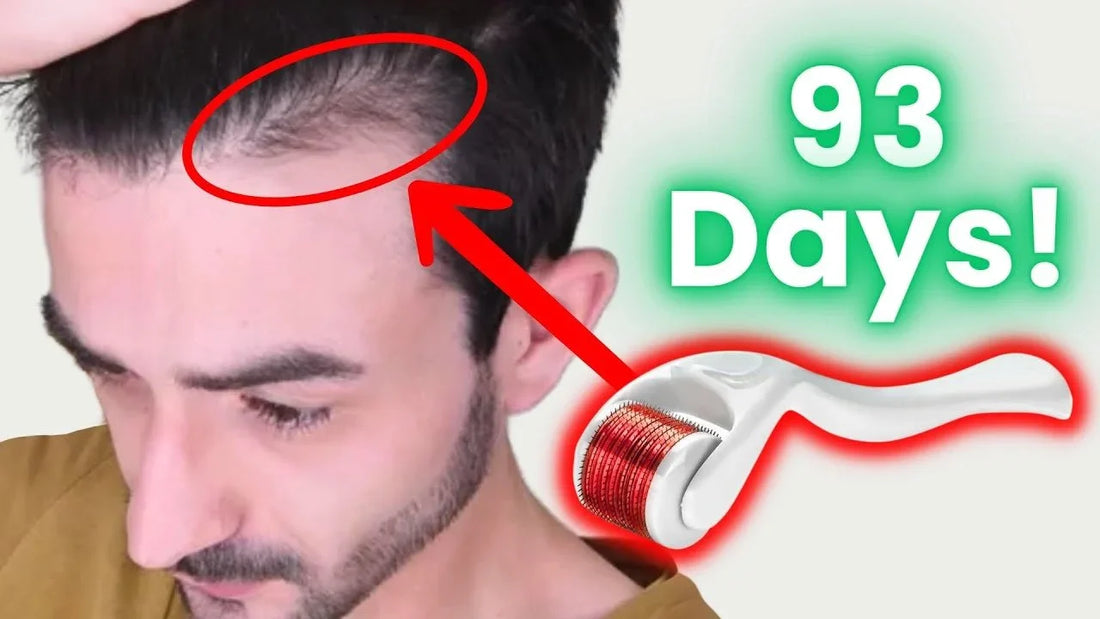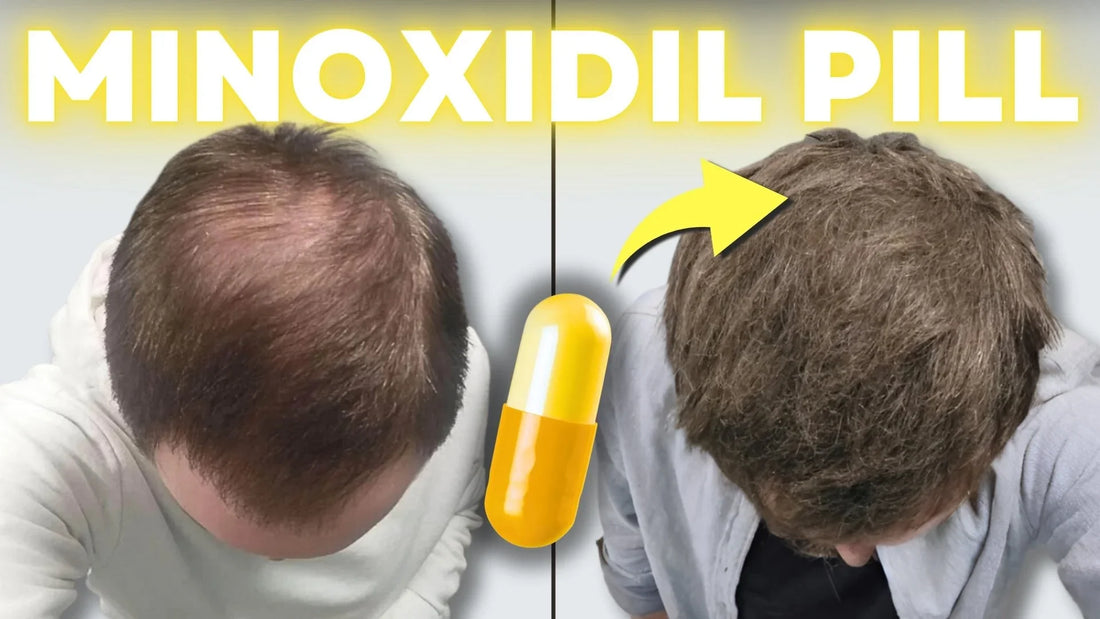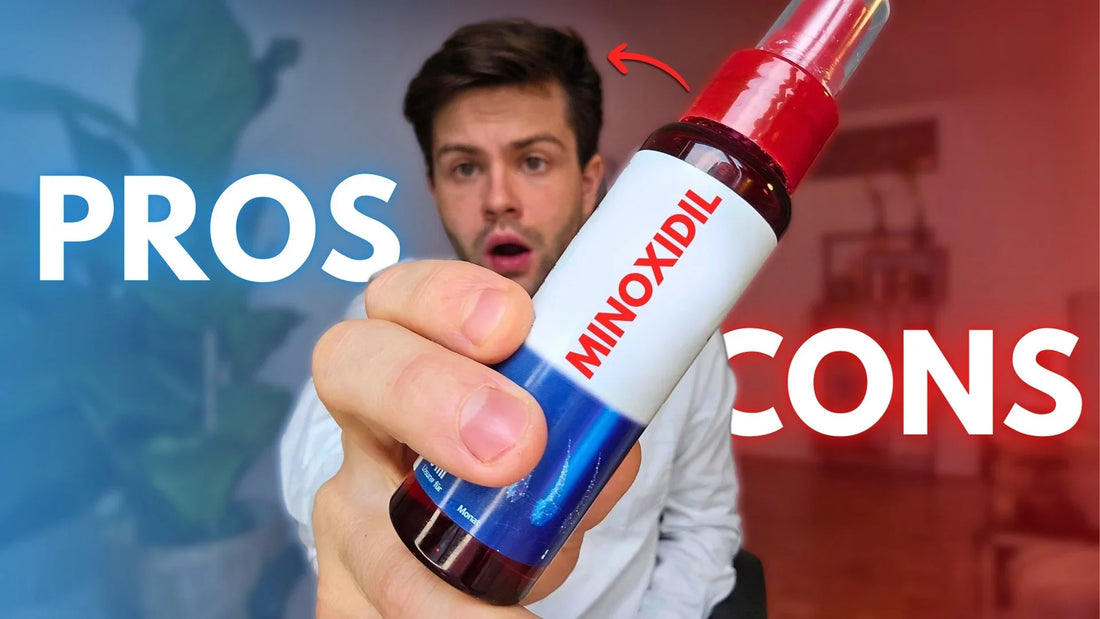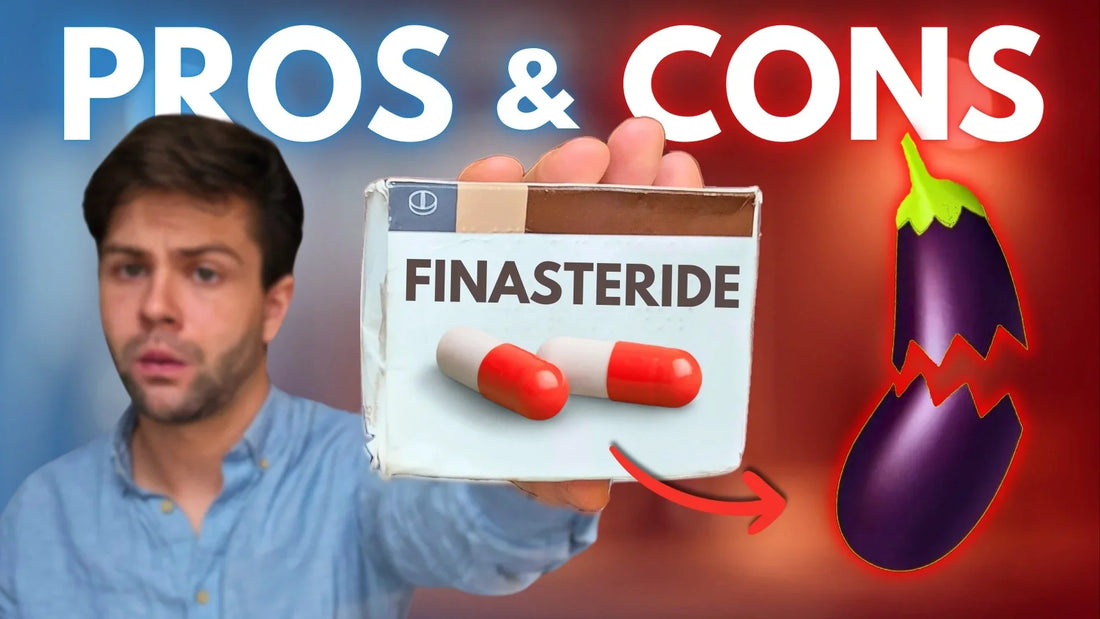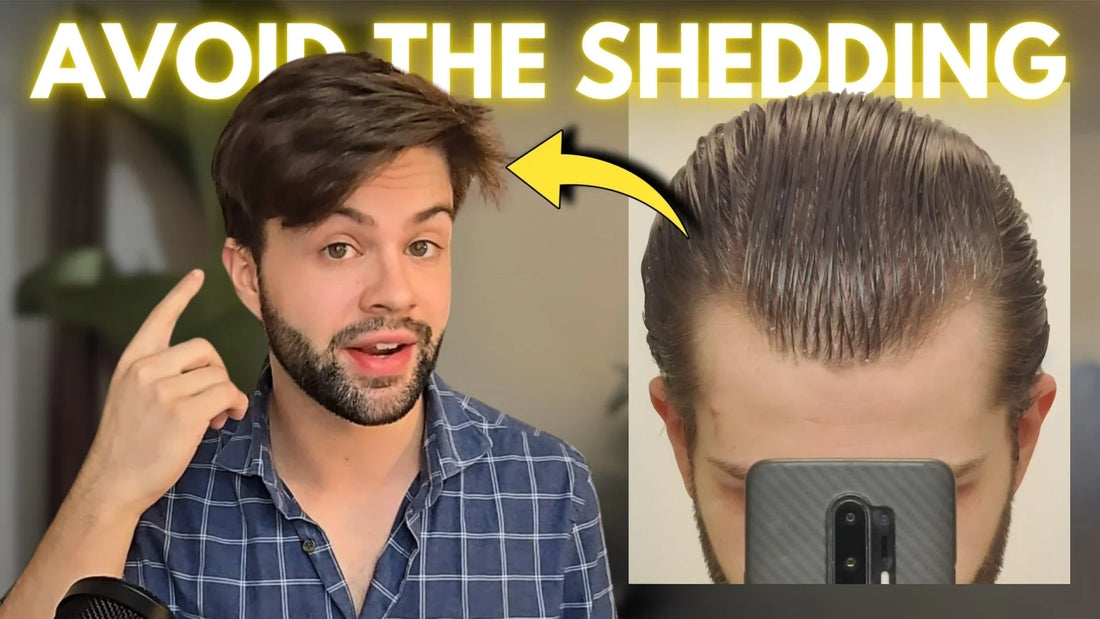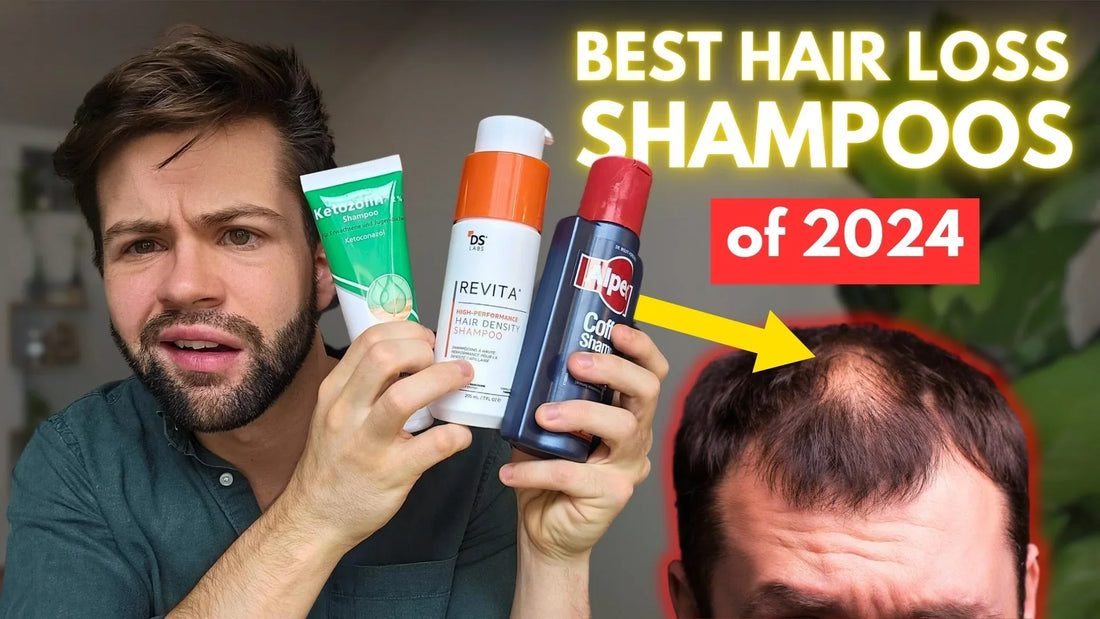News
My Finasteride Hair Regrowth Success Story (Month-by-Month Results)
Many people who have seen my videos know me for my incredible hair regrowth journey. Here’s a comparison of me before and just three months after starting minoxidil and the derma roller. Month 1 vs Month 3 results on Minoxidil and Derma Roller (before and after). Pretty insane, right? What most people don’t know is that before seeing these amazing results with minoxidil and the derma roller, I had been using another hair loss treatment on its own—finasteride. I was on finasteride way before starting minoxidil and derma rolling. So today, I want to share my story about how I first started balding at 20, how I began taking finasteride, and my month-by-month results from using ONLY finasteride. This way, if you're experiencing hair loss, or know someone who is, you'll have a good idea of what to expect. Finasteride block the production of DHT, the hair loss hormone. Hi, my name is Al Garrido, and welcome to another blog. I remember that when I first started to lose my hair at age 20, I was desperate to find a solution. I simply couldn’t allow myself to go bald so young. This is my personal opinion, but I feel like going bald makes you feel insecure, and robs you from a lot of opportunities that you would have otherwise had. I looked everywhere for videos and stories of people who managed to regrow their hair. That’s why I know that you will really appreciate this story if you are in a similar situation. Just take notes and comment below your questions and progress on any hair loss treatment. Before starting finasteride (month 0): Alright, so these are the first pictures of me before starting finasteride. As you can see, the situation was not good. In this picture in the middle, you can see how bad my temple area was looking, with a lot of hair gone by then. The same can be said about the crown area, which was clearly visible at that time. So all these are pictures of the month 0, when I started taking finasteride. Month 0, pictures from temple and crown area. Month 0, pictures from the crown area. Month 1 and 2 results (slight improvement): Going next to month 1, I’m not going to lie, there was a slight improvement, but not very much. You need to consider that finasteride can stop hair loss, but it’s a long process. Month 1 results. This is me on month 2 of taking finasteride. Here, believe it or not, I was starting to notice some new hair growth. It was very slight, but this before and after comparison should help you see the difference. The same can be said of the temple area, which was slowly but steadily showing some new baby hairs coming out. Month 2 results (crown area). Month 2 results (temple area). Month 3 results (happy about the progress): Month 3 was great! Whenever I compared the pictures with before, I was very happy because I knew I was making real progress. Month 3 crown area results. Month 3 temple area results. As you can see, I was still having noticeable hair loss, but it was substantially better than before. And with Finasteride, 3 months is still the beginning of the potential results, as we will see later. Month 4 results (THE SCARY HAIR SHEDDING): Anyway, this hype soon vanished, because, at month 4, something terrible happened. I got a hair shedding. Hair shedding, for those who don’t know it, is when your hair starts to fall out faster and more often than normal. The hair shedding can happen between month 1 and 4 of taking finasteride. This usually happens with finasteride and is usually a good thing. It means that the weak and old follicles are being replaced by new and healthier ones. The crown and temple area were significantly worse after the hair shedding. However, as you can imagine, it’s still very shitty when it happens. The month 4 pictures still showed better results than from the beginning, but worse if you compare it to month 3. Month 4 finasteride results on the temple area. Month 5 results (the recovery): Anyway, this is temporary, and at month 5, I already started to see sign of recovery. Here’s a before and after comparison of my crown area, which was visibly better at this point than compared to the beginning. Month 5 crown area results on finasteride. The same can be said of the temple area. Month 5 temple area results on finasteride. Month 6 (slow and steady): Month 6 was also great. Again, my hair loss is at this point still visible, but the situation has improved already significantly. Month 6 crown area results on finasteride. Not only did I recover some of my hair, but the existing hair was also starting to get thicker. Month 6 temple area results on finasteride. Month 7 (NIGHTMARE Once Again) and SEXUAL SIDE EFFECTS: But, one month later, the worst thing happened again. I got a SECOND hair shedding. And I believe this one was worse than the first one. Before I show you the pictures my my second hair shedding, let me briefly mention the topic of SIDE EFFECTS. Many people are afraid of taking finasteride, because of its potential sexual side effects, such as erectile dysfunction. What I think about this, is that the internet, once more, has exaggerated things, and it’s not as bad as you think. I’m not a doctor, so what I’m going to say is only based on my own experience and on everything I’ve read. I’ve never experienced ANY side effects with Finasteride. For me, it was completely safe. But it's true that a small percentage of people taking finasteride, have experienced them. They normally go away if you stop the treatment, so that’s good news. Anyways, I don’t think it’s something that should scare you from trying. If you are interested in learning more about that, I will leave you a study here, which talks about the percentages of people who have experienced side effects. Anyways, back to the topic. As I mentioned before, month 7 was without a doubt a terrible month, since I experienced my second shedding phase. Month 7 (second shedding phase). Month 7 (second shedding phase). I know it looks bad now, but a little shedding may be a good thing since your hair will grow back stronger and thicker than before. Which is what happened. Month 8 and 9 (the light at the end of the tunnel): This is month 8, and the hair started to grow back. Month 8 results on finasteride. Month 9 was even better. This is a before-and-after comparison between the beginning and month 9. Before and after finasteride results (9 months results). Months 10, 11 and 12 (3 months of steady growth): Month 10 was more or less the same. Here you can see the improved crown area in contrast to month 0. Month 10 results on finasteride (crown area). Here are now some pictures of months 11 and 12. Month 11 results on finasteride. Month 12 results on Finasteride. Year 1.5 on Finasteride (an unexpected improvement): Now, remember how I told you at the beginning that finasteride is a game of patience? The reason I say that is because, believe it or not, the best results from finasteride came after year 1. This is when the hair REALLY started to back as healthy and great as before. For example, this is me 1.5 years after starting finasteride. 1.5 years on Finasteride results. I remember my family asking me what the heck was going on. Why was a young boy like me, who was previously going bald, suddenly getting all his hair back? Year 2 (rocking the long hair): So now we enter year 2. This is when I started growing my hair long. Which, admittedly, was always a dream for me to do. Here you will be able to compare results from month 0 with year 2. Finasteride year 2 results. Finasteride year 2 results. Not only did I regrow that hair back, but I also managed to get a ton of new hair density. So yeah, finasteride is great, and any of this would not have been possible without finasteride. The downfall of my hair (again): That being said, finasteride is NOT a hair loss cure. The reason I say this is because 4 years after taking finasteride, I started to lose my hair again. Losing ground on finasteride on year 4. This can happen to very strong cases of hair loss, like mine. That’s when I started using minoxidil and the derma roller. With even GREATER results than when I was using only finasteride. Minoxidil, finasteride and derma roller results (Before and 3 months after). Until next time, I wish you a happy hair journey!
Learn moreHow to Microneedle with Minoxidil for Best Hair Results
Minoxidil is the best existing stimulator for hair growth today, and when used with a derma roller, people see much better and quicker results. You will find countless success stories of people on the internet. And I also regrew my hair in under a year using these treatments. So today, I will show you the right way to use minoxidil and a derma roller for the best and quickest results. Before and after results of minoxidil with the derma roller. Minoxidil is the most effective hair stimulator in existence today. It works by opening potassium channels and promoting the hair follicles' growth phase. Minoxidil opens the potassium channels, which helps promote hair growth. This encourages hair follicles to enter the growth phase again. It not only makes existing hair thicker but also regrows lost hair. On the other side, the derma roller is a device with tiny needles. You can use it on your scalp to create micro-injuries. These micro-injuries heal quickly, encouraging collagen and elastin fiber production. The derma roller promotes hair growth by stimulating the dermal papilla. Both of these treatments work great for regrowing lost hair, but using minoxidil and the dermaroller together is more effective. Before and after results of a 20 y/o male (derma roller and minoxidil 3-months results). To get the desired results, there are a few things you need to consider. First, choose the right minoxidil: Choosing the correct minoxidil is important to achieve the best and quickest results. You can find minoxidil in either liquid or foam form. Liquid minoxidil is good for easier skin absorption, which can lead to faster results. Foam minoxidil is convenient and easy to apply, it dries quickly, and is mess-free in your hair. Both are great and will regrow your hair, but if you are unsure, start with liquid minoxidil. You can measure the exact amount you want to use, and it’s cheaper. I will leave a link to both in the description. Liquid minoxidil is easy to apply. Foam minoxidil absorps faster. Second, apply minoxidil correctly: You only need to apply minoxidil in the area where your hair is already thinning or lost. If, like me, you have temple recession, it is enough to apply minoxidil only in the temple area. If you have more severe and extended hair loss, you can use minoxidil on other thinning areas of your hair. To start, create a parting in your hair to expose the thinning area. Now, use the dropper that comes with the minoxidil to use exactly 1 ml. Use the dropper to evenly distribute the minoxidil in the thinning area. Keep applying it until you have used the entire 1 ml. You should use minoxidil at least once a day for it to work. For quicker results, do this process twice a day—once in the morning and once in the evening. It is important to be consistent with minoxidil. If you don’t use the product every day, you won’t get the results you want. Only apply minoxidil where your hair is thinning or lost already. Third, use a dermaroller: Using the derma roller and minoxidil together improves results. Microneedling helps minoxidil to absorb effectively into the skin. The dermaroller comes in different shapes and sizes. Make sure you get one that has real needles. Real needle dermarollers help the skin heal faster and regrow hair quicker. You can find one like that in the description. Now, dermaroll before using the minoxidil to get better results. You can dermaroll and then apply the minoxidil after 24 hours. You should dermaroll at least once a month for it to work, but for quicker results, dermaroll once a week. This is my personal frequency too. Apply minoxidil 24h after derma rolling. Until next time, I wish you a happy hair journey. Adios!
Learn moreTOPICAL FINASTERIDE: The GREATEST Underrated Hair Remedy?
This user was using topical finasteride with minoxidil to treat his hair loss. After only three and a half months, he completely reversed his hair loss, as you can see. Before and 3 months after with topical finasteride. By using finasteride topically instead of taking the pill, he certainly got incredible results. But how did he do it exactly? Is using topical finasteride better and safer than oral finasteride? In this article, I will explain all you need to know about topical finasteride and how you can start doing it yourself at home. So stay until the end and find out. Topical Finasteride vs Oral Finasteride: First of all, if there's already a finasteride pill that people can take to fight their hair loss, why would someone use topical finasteride instead? Well, there are two main reasons for that. Topical Finasteride vs oral finasteride (propecia). The first reason is the side effects. Although it is generally very safe, consuming oral finasteride can cause side effects, especially sexual ones, in about 2% of the population. In the worst case, if you experience side effects, you can just stop using the pill, and the side effects should disappear. However, if you’re afraid of using the pill in the first place, like this particular user was, and don’t even want to try it, then topical finasteride is a great alternative. The second reason is that even if you’re taking the pill, it won’t necessarily stop balding completely. This is because DHT, which is the hormone that causes hair loss in the first place, is also produced inside the scalp of balding people. If you take the pill—one milligram of finasteride—you will likely reduce 70% of serum DHT, which is the DHT in your bloodstream, but only around 40% of the scalp DHT. Changes of serum and scalp DHT (oral vs topical finasteride). On the other hand, with topical finasteride, depending on the concentration (as we will see in a minute), you can reduce the DHT in your scalp by 50% or even more, while reducing serum DHT by just 25%. This is good because it means that you can get better results with fewer side effects. Topical finasteride’s perfect dose: Okay, great. So we’ve established that topical finasteride is, if not the same, perhaps even a little better than oral finasteride. But how much should you use? On one side, companies like Hims offer finasteride in a 0.3% solution, or the company Keeps offers a 0.25% solution. Keeps offers a 0.25% topical finasteride concentration, while Hims a 0.3% solution. What they don’t explain is what that really means, and why every company offers different percentages? Don’t worry, I will explain it to you. 1mg finasteride pill. This is one finasteride pill. Inside is 1mg of finasteride. A 0.3% topical finasteride solution means that there are three of these pills in 1ml of the solution. In the other example, the 0.25% Keeps solution would contain two and a half pills in 1ml. Hims' topical finasteride concetration. If 1ml is what you apply daily, isn’t that a lot? I mean, you’re applying the equivalent of three pills to your scalp, while with oral finasteride, you only take one pill. Although it may sound like a lot, and possibly more dangerous, the amount of topical finasteride that reaches the bloodstream is very low. That’s why it’s safer than taking the pill. But since these companies offer their solutions in different concentrations, which one is better for you? Well, several studies have determined the best concentration of topical finasteride. Here are the results: Topical finasteride: best dose for hair loss. The best concentration to address hair loss and reduce 70% of scalp DHT is a 0.25% finasteride per 1ml solution. This is about the same concentration that the company Keeps offers. So, even though they’re not sponsoring this content, I would recommend using that brand if you want to try it. How to do your own topical finasteride: Personally, I make my own topical finasteride solution at home, and in case you’re interested, I’ll show you how I do it. Just a few things first: this is not medical advice, and you should always consult with your healthcare professional. Second, I use a much lower concentration of topical finasteride because I’m already taking the pill. I use roughly a 0.011% concentration, which is seven of these pills in a 60-milliliter solution. Here’s how I do it: I use a typical coffee grinder to grind the seven finasteride tablets. Once that’s done, you’ll need a carrier solution. The perfect thing for that is just using a regular minoxidil bottle—that will work. If you don’t want to use minoxidil, you can make the solution yourself using 70% ethanol and 30% propylene glycol. These two ingredients can easily be found on Amazon. I add the powder to the solution, shake it for five minutes, and done! That's it. Until next time, I wish you a happy hair journey. Bye! Step 1: grind. Step 2: add to minoxidil or carrier solution.
Learn moreHow to Get the QUICKEST Hair Growth with a Derma Roller
Microneedling is a recently discovered technique used to treat several issues, such as acne, scar healing and skin rejuvenation. What's interesting is that when applied to the scalp, it has the potential to regrow hair lost due to hair loss. Even more fascinating is that when combined with minoxidil, people, including myself, see much better and faster results. So, that leaves us with the question: how much better is it when combined with minoxidil? Is it worth the inconvenience of adding minoxidil, or if you're already using minoxidil, should you add microneedling to the treatment? This is the intriguing part we're going to explore today. Before and after of microneedling with minoxidil (6 months results). To do so, we'll look at some anecdotal stories. While there are many scientific studies supporting what I'm about to share, there aren’t as many before-and-after pictures to accompany them. I believe it’s best for you to see the results with your own eyes to be convinced of their effectiveness and to set some real expectations. Only microneedling results: Okay, let’s start by looking at some results from people who have only used microneedling to regrow their hair. First, we have this user who was in the early stages of hair loss, with thinning around the temple area. 4 months derma rolling before and after results. He started using a dermaroller once a week, and four months later, these were his results. As you can see, he gained significant density around the temple area, and it seems like the dermarolling was enough to regrow his hair, for now. Some people have commented that in the first picture, he was pulling his hair to the left, and in the second picture, he was pulling it back, which might change the appearance of the hair. That may be true, but I still think the results are great, and I’ll leave it for you to judge. Comment below what you think! Next, we have another user who only used microneedling for six months. Here’s his hair in February and May. Microneedling (derma rolling) 4 months before and after results. Again, I think the results are impressive. However, even if he was able to partially regrow his hair and improve density, it’s definitely not enough to fully restore everything to how it was. Only minoxidil results: Let’s take a look at some pictures of people only using minoxidil to see how that works. First, we have this user who has been using topical minoxidil every day. Here’s his progress from April to June. Minoxidil 3-months hair regrowth results (before and after). Wow! From April to June, he experienced amazing regrowth. There’s quite a bit of debate about which treatment works better—minoxidil or microneedling. Some say dermarolling, others say minoxidil. Let me know in the comments below what you think. Anyway, let's look at the results of another user. This user was also using topical minoxidil 5% every day. Here’s his before and 10-week after picture. 10 weeks minoxidil hair results (before and after). The great thing is that these results are just after 10 weeks. With minoxidil, you can expect to continue improving your hair density even up to a year after starting the treatment. So 10 weeks, or 2.5 months later, is really too soon to see the full growth and the full results, and I’m sure he will continue to improve his hair. Minoxidil and derma roller results: Now, let’s look at the results of combining dermarolling with minoxidil, which is definitely the most effective way to treat hair loss. This combination is also recommended for those with advanced hair loss. Here’s a user who had a Norwood 6 level of hair loss. He started the combination of minoxidil and dermarolling, and four months later, these were his results. It’s fascinating to see how much hair he was able to regrow! Minoxidil and derma rolling results (before and after). This combination of treatments isn’t just for advanced cases; you can also use it when you're just starting to notice hair thinning, particularly around the temple area. Here’s another user who was in the early stages of hair loss. 3 months minoxidil and derma rolling hair results (before and after). After combining minoxidil with dermarolling for three months, these were his incredible results. Wow! This is honestly one of the best results I’ve ever seen.
Learn moreOral Minoxidil - The TRUTH to Unlocking Your BEST Hair Growth
Is oral minoxidil the best treatment to stop hair loss? If so, what's the correct dose to regrow hair and to avoid side effects? This user here took oral minoxidil daily to regrow his hair. Before and after results of taking oral minoxidil (6-months results). Not only did he regrow his hair on top, but he also increased the hair density of his eyebrows, as you can see here. Eyebrows thickening with oral minoxidil (before and after). But how he did it and how much he took without having side effects is not what you think. So today, we're going to look at the correct dose for the best and quickest hair growth results and also the potential side effects you should be aware of. IMPORTANT DISCLAIMER Before starting, you should know that this information comes from clinical studies, which I will link here [1] [2] [3]. But this article is not a substitute for personalized advice from a doctor, so always consult with your doctor first before starting any treatment. Having said that, let us start. What is oral minoxidil? Oral minoxidil is a drug that was first prescribed to improve blood circulation. But, when users took it, they noticed an unexpected benefit: hair regrowth. It's now seen as one of the most effective treatments for combating hair loss, and with the correct dose, you can see results in less than 90 days. However, many people are afraid of the potential side effects. The most common side effect is unwanted hair growth on the body and face. While many men don't mind this, it can be a reason for many women to reconsider the treatment. Rare side effects can also include dizziness, faster heartbeat, headaches, and trouble sleeping. However, those side effects are more uncommon when taking a small dose of the drug. According to a 2021 study, most people taking minoxidil tolerate low doses of the drug very well. Only 2% of the patients stopped taking the drug due to side effects, and the other 98% continued using it. So to minimize risks and still get the desired hair regrowth, it is crucial to follow the right dose. Typically, men start with at least 1 mg of oral minoxidil. This user, for example, took that amount. Before and after of oral minoxidil (temple area hair regrowth, 7-months results). He used 1 mg of oral minoxidil, and seven months later, he completely regrew his hair. But some people may have more severe hair loss and may need a higher dose for better results. The maximum dose recommended is 2.5 mg of oral minoxidil for women and 5 mg for men. For example, the user we saw before, who not only regrew his hair but also his eyebrows, was taking 2.5 mg of oral minoxidil a day. And then we have this other user who took 5 mg of oral minoxidil to regrow his hair. 5mg of oral minoxidil before and after results. Eleven months later, he managed to completely regrow his hair. And what's remarkable is that he did it without using any other treatments such as finasteride. None of the users we have seen reported having unwanted side effects. How to take oral minoxidil? But if you take the treatment and want to increase the dose, there are a few things you need to consider. As this medical study recommends, you should do so in 0.25 mg increments every three months. So if you're starting, for example, with 1 mg of minoxidil a day and you want to increase it to 2 mg, you should increase the dose by 0.25 mg every three months. This is important to ensure your body reacts properly and to avoid unwanted side effects. Please remember that oral minoxidil is also a blood pressure treatment and should be taken carefully with a doctor's advice. If you're looking for a safer option for hair loss, however, consider topical minoxidil. It gives similar or the same benefits without the risk of unwanted side effects, and since it is considered safe, you don't need a doctor's prescription for topical minoxidil. This makes it more convenient as you can find it on Amazon and start using it right away.
Learn morePros & Cons of Minoxidil for Thinning Hair
A lot of people ask about the benefits and risks of using Rogaine. I’ve made videos on hair loss for years, and I personally use Minoxidil. But there’s still a lot of confusion about the pros and cons of this product. So let me help clear things up. What is Minoxidil and how often should you use it? First, Minoxidil is a liquid you put on your scalp, often twice a day. The companies recommend using it once in the morning and once at night. But since Minoxidil stays active for around 22 hours, you can use it just once a day and still get good results. This is what I do myself. MInoxidil for hair loss (Kirkland). Will it grow all your hair back? It’s important to know that Minoxidil won’t grow back all your hair if you’re already bald. So if you think it will give you a full head of hair, it won’t. But what it can do is slow down hair loss. Remember, genetic hair loss usually gets worse over time. So if Minoxidil can slow it down and maybe even thicken your hair, that’s a big benefit. It might not make all your hair come back, but it can make a positive change in how your hair looks. You also have to use Minoxidil every day for it to work. If you don’t use it regularly, you’ll notice more hair shedding. Minoxidil puts your hair into a growth phase, so if you use it randomly, your hair will shed more often. It’s normal to shed in the first few weeks, but after that, your hair should get thicker and fuller. What happens if you quit Minoxidil? Another question people ask is, “What if I stop using Minoxidil? Will I lose all my hair?” Not exactly. If you stop, your hair will just go back to how it would have been if you’d never used it. Before Minoxidil, Minoxidil results, and stopping Minoxidil. Some people use this as a reason not to start, but I think that’s a mistake. It’s like brushing your teeth—you wouldn’t stop just because they might get bad if you quit. Or think about exercise: if you work out, you stay strong. If you stop, you lose strength over time, but that doesn’t mean you shouldn’t start. It’s the same with Minoxidil.
Learn morePros & Cons of Finasteride for Hair Loss
A lot of people ask about the benefits and risks of using finasteride. I’ve been talking about hair loss solutions for years, and I know there’s still a lot of confusion around this medication. So let’s go over the key things you need to know about finasteride. What is finasteride and how does it work? First, finasteride is a pill you take once a day, and it works by lowering a hormone called DHT in your body. DHT is one of the main reasons for hair loss in people with male-pattern baldness. By reducing DHT, finasteride helps slow down hair loss and can even encourage some hair regrowth. It’s important to understand that finasteride isn’t an instant fix. It can take a few months to start noticing results, and you’ll need to keep taking it to maintain those results. So if you’re looking for something that works overnight, finasteride isn’t that kind of solution. But if you’re patient and consistent, it can really make a difference. Finasteride stops the production of DHT, which promotes healthier follicles. What about Finasteride’s side effects? One thing that often worries people are the potential side effects. Some people report issues like decreased libido or mood changes. However, these side effects are pretty rare, and many people don’t experience any issues at all. It’s also important to talk to your doctor about any concerns you have; they can help you decide if finasteride is right for you. Can I have children while taking Finasteride? Now, another concern some people have is about having children while using finasteride. The good news is that finasteride does not necessarily affect your ability to have children. However, if you’re planning to start a family, you can stop taking finasteride while trying to conceive, and then resume once you’ve had your child. This is something you can discuss with your doctor if it’s an important issue for you. What happens if I stop taking Finasteride? Another common question people have is, “What happens if I stop taking finasteride?” Just like with Minoxidil, if you stop, your hair will eventually go back to how it would have been without the medication. This doesn’t mean you’ll lose *all* your hair, but the benefits will fade over time. I think it’s a mistake to avoid finasteride just because of this. It’s like eating healthy—just because you might lose some of those benefits if you stop doesn’t mean it wasn’t worth it to begin with. Conclusion And remember, genetic hair loss is progressive. This means that, if left untreated, it will likely get worse over time. Finasteride can help slow it down, which can be really valuable for anyone looking to keep the hair they have. These are some of the main things people need to know about finasteride. I hope this helps clear up some confusion.
Learn moreHow to AVOID Shedding Hair with Minoxidil and Finasteride
If you have started Finasteride, Minoxidil, or any other hair loss treatment, you are probably worried about the hair shedding phase. I know this personally from when I started losing my hair, but there are many simple tricks you can use to reduce the shedding phase and start regrowing your hair as soon as possible. So today, I will show you the shedding phase I had, how long it lasted, and tell you the things that worked for me to reduce it and start regrowing my hair sooner. Shedding phase of the hair after starting a hair growth treatment. Hi, if you're new to the channel, my name is Alvaro. The shedding phase is probably the scariest part of starting any new hair loss treatment. I mean, if you're already balding, it's terrifying seeing your hair starting to fall faster than it did before. It's also scary because you don't know if this is temporary and your hair will eventually grow back or if you're just continuing to go bald. But don't worry, because we are going to talk about this and the best solutions to make sure you get through the shedding phase as quickly as possible. Before I tell you the remedies to avoid a long shedding phase, let me show you what my shedding phase was like. This was me before I started using Minoxidil, Finasteride, and the derma roller. As you can see, I had significant thinning, especially in the temple area. My hair was already looking bad. My hair results on the big 3 (before and after). I started these treatments, and if you're curious, the first shedding phase usually occurs after the first four weeks of starting a new hair growth treatment. So during the first four weeks, nothing really happened. Then, in week four, you will notice a rapid increase in hair fall, which is exactly what happened to me. You can see it here in week four compared to week one, where my hair was looking much worse and much thinner. I remember seeing hair everywhere—on my pillow, in the shower, and in the sink. Every time I ran my hand through my hair, I would find three or four hairs. The worst part was the itching. My scalp was unbearably itchy, and I had to scratch it all the time. So you might ask yourself, "Who in their right mind would go through this just to lose more hair than they did before?" Well, it turns out that it all worked out in the end because four weeks later, in month two, I started to see some hair regrowth. Month three was even better, as you can see here compared to month one. That's the whole idea behind using these hair growth treatments. Unfortunately, there's nothing you can really do to completely avoid the hair shedding phase. It's going to happen whether you like it or not, but there are many things you can do to reduce the time you're shedding hair. These are the things that worked for me: 1. Start all hair treatments at once: The big 3 for hair loss If your plan is to start a combination of treatments, such as Finasteride with Minoxidil or Minoxidil and a derma roller, don't use them separately. In other words, if you're starting Finasteride, you will go through one shedding phase. If you later decide to start using Minoxidil, you will go through a second shedding phase because each treatment works differently. So if you begin these treatments at different times, you will go through several shedding phases, which is something you will want to avoid. It's better to start all the treatments simultaneously. That way, you will have one big shedding phase, and that's it. After that, you can expect your hair to continue growing. 2. Use a ketoconazole shampoo: Ketoconazole Shampoo for hair shedding (Nizoral) Ketoconazole shampoo, also known as Nizoral, is without a doubt one of the best hair loss treatments today. The reason is that it has some anti-inflammatory properties, which is essential because it can help shorten the shedding phase after starting a new hair loss treatment. Not only that, but remember how I mentioned the intense itching during the shedding phase? The ketoconazole shampoo is a game changer for that. It helps calm the itching significantly—kind of like submerging your head into cold water. I highly recommend it because it will make your hair journey much easier. I've left a link in the description to a ketoconazole shampoo you can buy on Amazon.
Learn moreThe BEST Hair Loss Shampoos I Tested in 2025: My Honest Review
Hair loss sucks. It’s frustrating, disheartening, and, unfortunately, something many of us experience. The good news? There are plenty of treatments out there today that can help prevent or slow it down. If you’re on the hunt for a solution, shampoos can be a great addition to your hair care routine. But not all shampoos are created equal. In this post, I’ll share **the three best shampoos for hair loss** I’ve personally tested this year, along with how to use them for the best results. 1. Alpecin Caffeine Shampoo Alpecin shampoo for hair loss This one’s a classic, and for a good reason. Alpecin contains caffeine, which is known to stimulate hair follicles and improve scalp health. - How I Use It: I apply Alpecin three times a week—Monday, Wednesday, and Friday. To let the caffeine penetrate effectively, I leave it on my scalp for about 7 minutes (even though the instructions recommend only 2 minutes). - Results: Over time, I’ve noticed a reduction in shedding and slightly stronger hair. However, this isn’t a miracle cure—it requires consistency, and results typically take around 3 months to become noticeable. - Key Tip: Like most hair loss treatments, if you stop using it, the benefits fade. 2. Revita Shampoo by DS Laboratories Revita shampoo for hair loss Revita takes things up a notch with a powerful mix of ingredients, including caffeine, biotin, and niacinamide. - How I Use It: I alternate between Revita and Alpecin, using Revita on Tuesdays, Thursdays, and Saturdays. - Results: Revita helped my hair look and feel thicker, which was particularly important when I was going through the initial shedding phase of other hair treatments. While this thicker hair effect is mostly visual, it’s a confidence booster during the regrowth process. - Downsides: It’s pricey at $35 per bottle, but since I only use it three times a week, one bottle lasts 2-3 months. - Missing Ingredient: Revita used to include ketoconazole, a game-changer for hair loss, but it’s no longer part of the formula. 3. Ketoconazole Shampoo (e.g., Nizoral) Ketoconazole (Nizoral) shampoo for hair loss This is the most important shampoo for regrowing hair. It tackles dandruff, reduces scalp inflammation, and can significantly decrease shedding. - How I Use It: I use ketoconazole shampoo only once a week to avoid drying out my hair. I time it for the day after microneedling, as the antifungal properties help clean the scalp and prevent infections. - Why It’s Essential: Ketoconazole has been shown to block DHT, a hormone linked to hair loss. Plus, it soothes the itchiness that often comes during shedding phases when using treatments like minoxidil or finasteride. - Pro Tip: Microneedling before using this shampoo enhances its effectiveness by allowing the active ingredients to penetrate the scalp more deeply. Final Thoughts If you’re serious about tackling hair loss, combining these shampoos can make a big difference. Here’s a quick recap of how to use them effectively: 1. Alpecin: 3 times a week to strengthen hair. 2. Revita: Alternate 3 days a week for thicker-looking hair. 3. Ketoconazole: Once a week to combat dandruff, inflammation, and shedding. Consistency is key, so stick with your routine for at least 3 months to see results. And remember, shampoos work best as part of a holistic hair care plan—pair them with treatments like minoxidil, finasteride, or microneedling for optimal results. Have you tried any of these shampoos? Let me know your thoughts in the comments below!
Learn more

